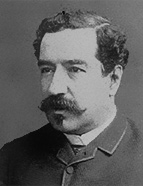

G. Pereira joined several scholarly organisations, including the Real Associação dos Arquitectos Civis e Arqueólogos Portugueses [Royal Association of Portuguese Civil Architects and Archaeologists] (RAACAP) (1863), whose Boletim he directed towards the end of his life, as well as the Sociedade de Geografia de Lisboa [Lisbon Geographical Society] (SGL) (1875) and the Sociedade Literária Almeida Garrett [Almeida Garrett Literary Society]. He was also a corresponding member of the Archaeology Section of the Instituto de Coimbra [Coimbra Institute] (1852) and the Academia Real das Ciências [Royal Academy of Sciences] (1783).
Considered by Ramalho Ortigão to be the spiritual heir of André de Resende and Frei Manuel do Cenáculo, G. Pereira — a monarchist sympathiser and, like many thinkers of his era — devoted his life to studying the history, art, and archaeology of his birthplace. He strongly defended local heritage and the value of the Évora public library’s collections (including archaeological ones), promoting them through numerous monographs and articles, some of which appeared in periodicals such as the Gazeta Setubalense, the Universo Illustrado, O Occidente, the Revista Archeologica e Historica, the RAACAP Boletim and the Geographical Society Boletim.
Having passed away without children, G. Pereira rests in the section reserved for Évora's most illustrious figures, following the transfer of his remains from the Alto de S. João Cemetery (Lisbon), in 1950. In 1934, writer and journalist João Rosa compiled, annotated, and published a selection of G. Pereira's writings, accompanied by Pereira's own drawings, under the title Estudos Diversos [Diverse Studies]. A decade later, the centenary of G. Pereira's birth was commemorated with an exhibition at the Évora Public Library and District Archive, and his name was bestowed upon a high school, a school library, and a street in the centre of Évora.
Archives and other primary sources: Archive of the Academia Nacional de Belas Artes [National Academy of Fine Arts] in Lisbon: National Monuments Commission — Correspondence; National Monuments Commission — Corresponding Members; Higher Council of National Monuments — Correspondence; Higher Council of National Monuments — Minutes Book, 1900-1907; Council of Art and Archaeology — Minutes Book of the Sessions of the National Monuments Commission (L.º 258, 259, 262); Historical Archive of the Association of Portuguese Archaeologists Minutes Books of Board Meetings, 1871-1912; Minutes Books of General Assembly Meetings, 1871-1912; National Archives of Torre do Tombo — Directorate-General for Books, Archives, and Libraries: National and international artistic and scientific correspondence with J. Possidónio da Silva; Manuscripts Collection of the Reserved Reading Room at the National Library of Portugal: Pereira, Gabriel, [Collection of Drawings], MSS. 204, no. 39; Pereira, Gabriel, [Notes on the History of Art], COD. 13488; Boletim da Real Associação dos Architectos Civis e Archeologos Portuguezes, 9th Series, Tome 9, No. 3 (1901), Lisbon, Typographia Lallemant, 1901; Boletim da Real Associação dos Architectos Civis e Archeologos Portuguezes, 4th Series, t. 9, no. 5, Lisbon, Typographia Lallemant, 1902; Boletim da Sociedade de Geographia de Lisboa, Series 17, no. 5 (1898-1899), Lisbon, Imprensa Nacional, 1900.
This work is financed by national funds through FCT - Foundation for Science and Technology, I.P, in the scope of the projects UIDB/04311/2020 and UIDP/04311/2020.
